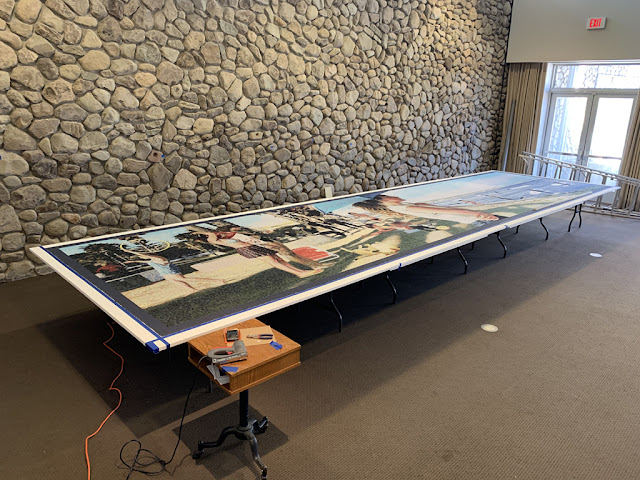 |
| Sanctuary Wall tapestry installation The Cathedral of Our Lady of the Angels | Los Angeles, California | September 2020 |
 |
| Sanctuary Wall tapestries The Cathedral of Our Lady of the Angels | Los Angeles, California | January 1, 2021 |
 |
| Sanctuary Wall | View from the cathedral nave The Cathedral of Our Lady of the Angels | Los Angeles, California | January 1, 2021 |
 |
| Sanctuary Wall tapestries | Five Panels | Jacquard Tapestry | 30 x 9.5 feet each | John Nava 2020 The Cathedral of Our Lady of the Angels | Los Angeles, California | January 1, 2021 |
 |
| Detail - Center Panel | Sanctuary Wall tapestries The Cathedral of Our Lady of the Angels | Los Angeles, California | January 1, 2021 |
 |
| Sanctuary Wall | View from the cathedral transept The Cathedral of Our Lady of the Angels | Los Angeles, California | January 1, 2021 |
The tapestries are composed of layered images. Overarching all is a great circular geometric pattern meant to evoke the infinite - the Divine. It radiates from the center panel and is derived from Cosmatesque mosaics found throughout Romanesque period churches in Italy especially. The pattern mirrors a similar one that appears above the scene in the tapestries at the opposite end of the church in the Baptistry. The theme of a radiating circular pattern begins in this cathedral on the tiled floor centered below the altar.
In the left and right hand tapestry panels the ground is overlaid with another linear pattern - the streets of Los Angeles.
Making sense of this image of our own city bonded with the great circular design is a layer of text that appears in the two inside panels on either side of the center. These words come from the Book of Revelation. “See the home of God is among mortals, God will dwell with us, And we will be with God, And we will be God’s people.”
The images of the angels that accompany Our Lady appear in the left and right side panels. These are derived from 17th century types painted by indigenous artists trained by friars during the early days of the Church in the Americas.
Mary, in the center tapestry, is cloaked in traditional blue. Her white chemise features a golden floral design drawn from the pattern of the embroidered robes of Our Lady of Guadalupe. This reference to the holy tilma, along with Mary’s Latin American features, present this woven Virgin as, also, a “New World” image of Our Lady.
The figure of Mary glows at the center of the composition. Her gesture is a classic one of openness, of reception, of acceptance towards the faithful before her. At the same time, however, her hands also stretch downward to meet the raised hands of her Son on the bronze cross below her. This relationship connects the tapestry image to the specific sacred elements and space of this church. As the central figure in a cathedral named for her the image aims to convey a certain serenity and gravity and to be a focus of inspiration and source of solace.
John Nava





